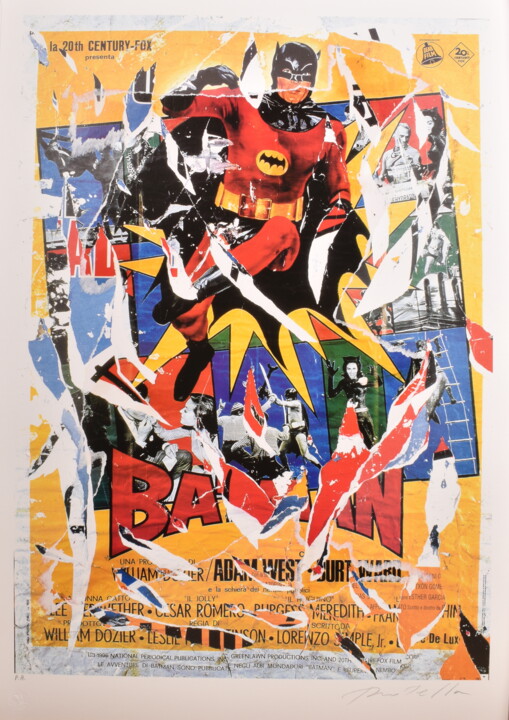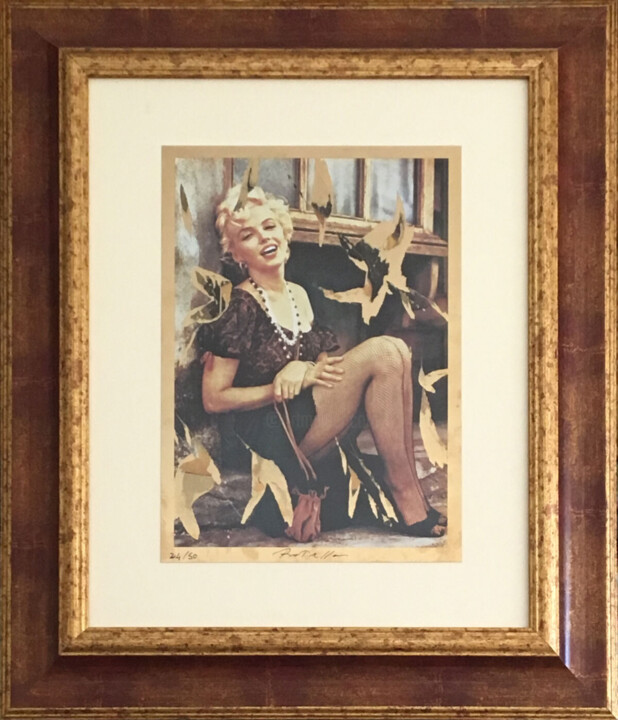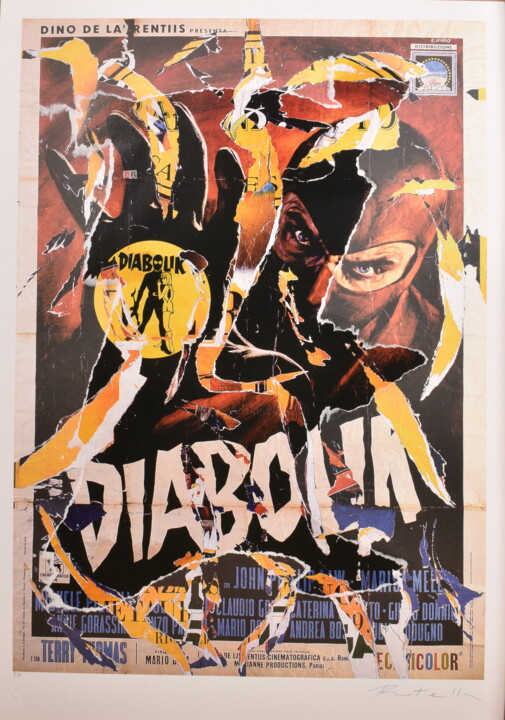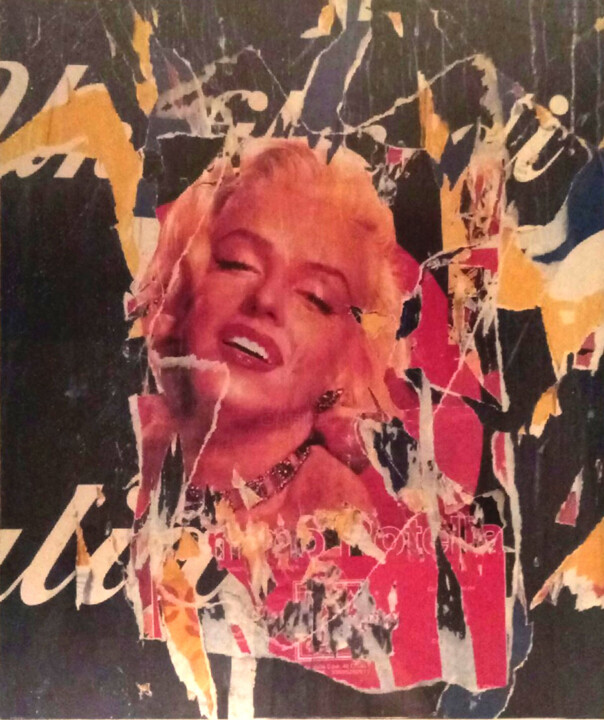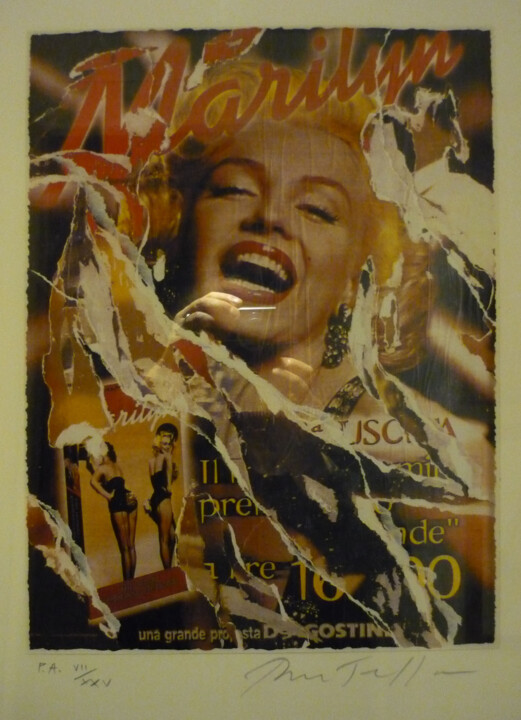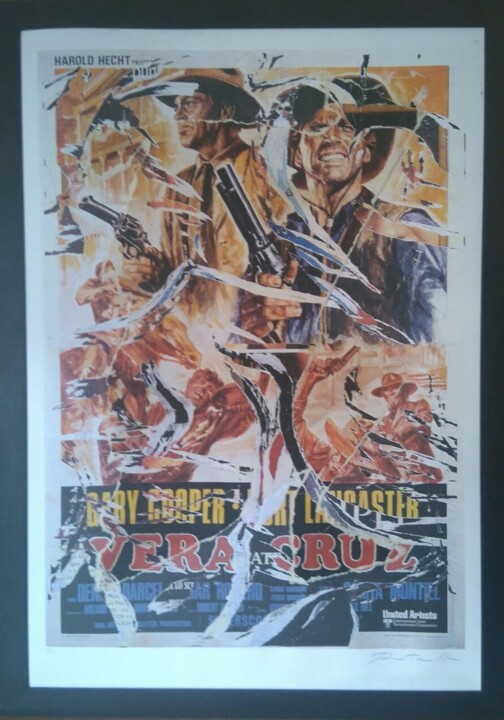 Mimmo Rotella, 1975.via Wikipedia
Mimmo Rotella, 1975.via Wikipedia
Mimmo Rotella
Mimmo Rotella, born Domenico Rotella on October 7, 1918, in Catanzaro, Italy, is renowned as a pivotal figure in post-war Italian art. He gained recognition as a major influence in post-war European art, primarily recognized for his décollage and psychogeographic works created from torn advertising posters. He was connected with the Ultra-Lettrists, a branch of Lettrism, and later became a member of the Nouveau Réalisme movement, established in 1960 by art critic Pierre Restany.
In 1944, Mimmo Rotella graduated from the Art School of Naples. From 1944 to 1945, he taught drawing in Catanzaro. In 1945, he returned to Rome, where, after his initial work in figurative art and early experiments, he began creating new-geometric paintings. In 1947, he started participating in exhibitions with the Exhibition Board of Fine Arts and the annual Art Club.
In 1951, Mimmo Rotella first engaged with French art by exhibiting at the Salon des Nouvelles Réalités in Paris. Between 1951 and 1952, he was awarded a scholarship from the Fulbright Foundation, allowing him to travel to the United States as an "Artist in Residence" at the University of Kansas City. During his time in the U.S., he held his second solo exhibition at the Rockhill Nelson Gallery in Kansas City in 1952. While in America, Rotella had the opportunity to connect with key figures of emerging artistic movements, including Robert Rauschenberg, Claes Oldenburg, Cy Twombly, Jackson Pollock, and Yves Klein.
Starting in 1953-1954, Mimmo Rotella began exploring two parallel artistic paths: décollage and retro posters. Unlike décollage, where layers of material are often manipulated and intertwined, the retro d'affiche preserves the "urban relic" quality of the posters. These works are more restrained in expression, often lacking color and presenting a gritty, raw surface. This approach, compared to décollage, represents a deeper exploration of informal language, a shift that would become more pronounced in the 1960s as Rotella's décollages began to reflect the emerging influence of pop art.
 Mimmo Rotella - Today at the Metropolitan (1980). Printmaking, Silkscreen
Mimmo Rotella - Today at the Metropolitan (1980). Printmaking, Silkscreen
The birth of decollage
In the early 1950s, Rotella revolutionized the art world with his invention of "decollage," a technique that involves tearing and reassembling posters found on the streets of Rome. Décollage is an artistic technique that contrasts with collage by removing rather than adding elements. Instead of incorporating new pieces, it involves starting with an existing artwork from which parts are removed. The concept of décollage emerged during a period of "artistic crisis" and was influenced by a trip to the US, where the artist interacted with members of the New Dada movement. Upon returning to Rome, the artist was inspired by torn posters around the city, bringing them into the studio to work on them. This led to the creation of canvases where pieces of torn posters were layered and pasted. The artist aimed to discover a new form of artistic expression while bestowing artistic value upon everyday objects that had been removed from their original context. This innovative approach made him one of the leading figures in the Nouveau Réalisme movement, alongside artists like Yves Klein and Arman.
Rotella’s decollage works quickly gained international attention. His art captured the vibrant, chaotic energy of urban life, reflecting the cultural and social changes of the 1950s and 1960s. By deconstructing commercial imagery and advertising posters, Rotella critiqued consumerism while simultaneously celebrating popular culture. His work was featured in prominent exhibitions across Europe and the United States, solidifying his place as a major contemporary artist.
In 1960, he joined the New Realism movement, although he did not sign the manifesto. This movement, spearheaded by theorist Pierre Restany, included artists such as Yves Klein, Spoerri, Tinguely, César, Arman, and Christo. While the group was involved in décollage, French artists Hains, Dufrêne, and Villeglé were also working with décollage independently during the same period. Alongside his décollages, Rotella created assemblages from objects purchased from junk dealers, such as bottle caps and cords. The influence of Pop Art and Abstract Expressionism, along with the Informal art movement and the spatial and material explorations of Italian artists like Lucio Fontana and Alberto Burri, played a significant role in shaping Rotella's artistic direction.
 Mimmo Rotella - Batman. Multiple decollage with poster tears applied on silkscreen support on cardboard. 100 x 70 cm
Mimmo Rotella - Batman. Multiple decollage with poster tears applied on silkscreen support on cardboard. 100 x 70 cm
Later career
Using typographic tools, between 1967 and 1973 he created his Art-typo, prints chosen and reproduced freely on the canvas. This procedure is able to overlap and superimpose advertising images, reversing the previous approach. In the early seventies produces some works by intervening on the advertising pages of magazines with the use of solvents and reducing or state at the imprint (frottage) or deleting one (effaçage).
In 1980, he moved from Paris to Milan. During the 1980s, he developed the "blanks" or affiches couvertes, which involved using white sheets to cover outdated advertising posters. In 1984, he created the second series of works focused on cinema, titled “Cinecittà 2”. After 1986, he began working on the “Sovrapitture” series, drawing inspiration from graffiti. This series features interventions where he painted over torn posters affixed to canvas.
In the 1980s and 1990s, Rotella continued to innovate, experimenting with new techniques such as "cinecittà," where he used film posters as his medium, and "sovrapitture," a process that involved overpainting torn posters. Despite his success, Rotella remained dedicated to exploring the limits of visual language and the materiality of art.
In 1990, he took part in the exhibitions “Art et Pub” at the Centre Pompidou in Paris and "High and Low" at the Museum of Modern Art in New York. In 1992, he was honored with the title of 'Officiel des Arts et des Lettres' by the French Minister of Culture, Jack Lang. Following the artist's wishes, the Fondazione Mimmo Rotella was established in 2000 to collect and catalog works and documents from his artistic career. In 1994, he was featured in the exhibition “Italian Metamorphosis" at the Guggenheim Museum in New York. He returned to the Centre Pompidou in 1996 for the exhibition “Face à l'Histoire", and also participated in the “Halls of Mirrors" exhibition at the Museum of Contemporary Art in Los Angeles, which toured globally. Additionally, he created a series of works dedicated to Federico Fellini.
Mimmo Rotella passed away on January 8, 2006, in Milan, leaving behind a profound legacy. His works are housed in major museums and collections worldwide, including the Centre Pompidou in Paris and the Museum of Modern Art in New York. Rotella's decollage technique remains influential, and he is remembered as a trailblazer who redefined the boundaries of contemporary art.
 Mimmo Rotella - Marilyn (2009). Printmaking, Lithograph
Mimmo Rotella - Marilyn (2009). Printmaking, Lithograph
Mimmo Rotella: notable works and museum collections
Mimmo Rotella's notable décollages include “Muro Romano” (1958), held at the National Gallery of Art in Washington D.C.; “Untitled” (1958) from The Menil Collection in Houston; “Not in Venice” (1959) at MART in Rovereto; and “A Strappo Deciso” (1960) displayed at MACRO in Rome. His other significant works are “Avventuroso” (1961) at the Centre Georges Pompidou in Paris, “With a Smile” (1962) at Tate Modern in London, “Little Monument to Rotella” (1962) at MoMA in New York City, and “Casablanca” (1965–80) at the Fondazione Solomon R. Guggenheim in Venice.
Rotella's work is represented in numerous museum collections around the world. These include the Solomon R. Guggenheim Museum in New York City, MACI — Museo Arte Contemporanea in Isernia, MACRO — Museo d'Arte Contemporanea in Rome, MART — Museo d’Arte Moderna e Contemporanea di Trento e Rovereto in Trento, and The Menil Collection in Houston. His works are also housed in MUMOK — Museum Moderner Kunst Stiftung Ludwig in Vienna, Museum Ludwig in Cologne, Musée National d’Art Moderne – Centre Pompidou in Paris, MUSEION - Museum for Modern and Contemporary Art in Bolzano, Museo d'Arte Contemporanea di Villa Croce in Genoa, Museo Fisogni in Tradate, the National Gallery of Art in Washington, Sintra Museu de Arte Moderna – Colecção Berardo in Sintra, Sprengel Museum in Hannover, Staatsgalerie Stuttgart in Stuttgart, Tate in London, and the Tel Aviv Museum in Tel Aviv.
 Mimmo Rotella - Once upon a time. Multiple decollage with poster tears applied on silkscreen support on cardboard. 100 x 70 cm
Mimmo Rotella - Once upon a time. Multiple decollage with poster tears applied on silkscreen support on cardboard. 100 x 70 cm
Mimmo Rotella's impact on the art world is profound. His pioneering techniques not only challenged traditional notions of art but also paved the way for future generations of artists. Rotella's work continues to inspire contemporary artists, particularly those interested in the intersections of art, media, and society. His ability to transform the mundane into the extraordinary through the simple act of tearing posters is a testament to his creative genius and enduring influence.


 Selena Mattei
Selena Mattei

